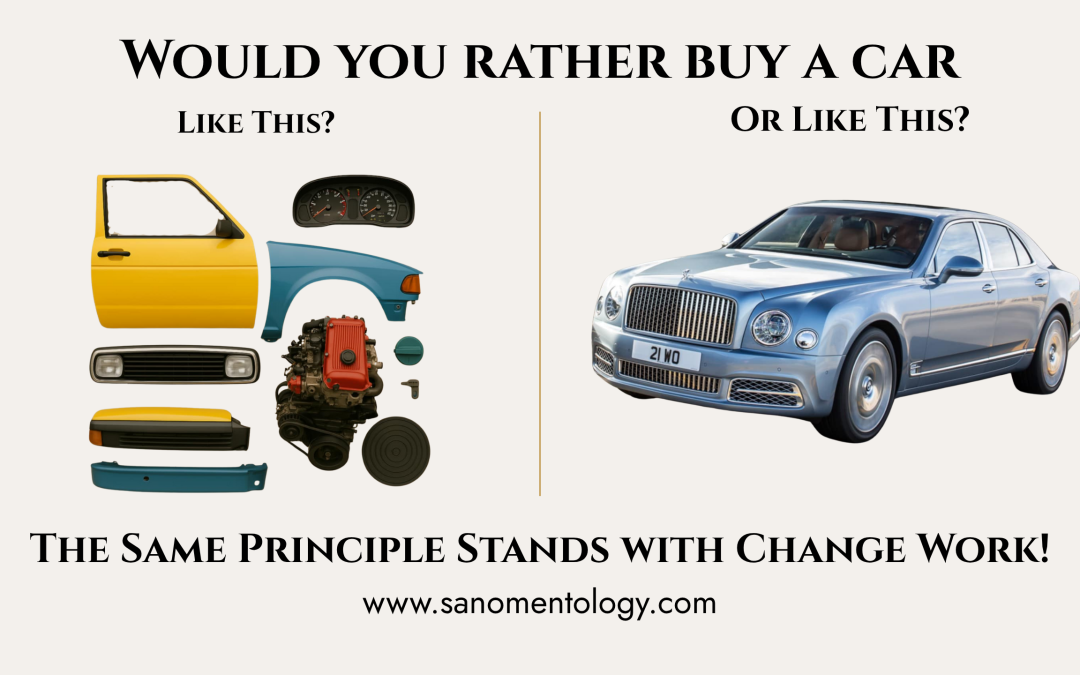The dangers of cheap and overpromising training – a working analogy.
Imagine that moment. You’ve saved up, made plans, envisioned the journey ahead.
You’re finally buying a car, ready to embrace the freedom it promises. But then, when you arrive to claim it, reality is a letdown. Instead of the smooth, polished, fully functional machine you expected, you’re handed a heap of disjointed parts. Wheels without tires. A chassis without an engine. Random fragments that, on their own, are useless.
And the worst part? You don’t even realize what’s missing. If you’ve never seen a complete car, how would you know it’s supposed to come with everything, perfectly integrated? You accept each part as it’s handed to you, thinking, This must be how it works. You piece together what you can, but the result? A chaotic blend of mismatched components—a Mini engine forced into a Ford frame, struggling to turn Land Rover wheels. It’s sluggish, unreliable, and worst of all, it doesn’t take you where you need to go.
This is what the world of personal development, change work, and therapy has become. Broken. Fragmented. Partial solutions dressed up as the answer. Some practitioners or trainers give you the wheels, just enough momentum to feel like something is happening. Others offer an engine, but without the right frame, it can’t carry you forward. And some? They’re offering no more than the equivalent of those tiny, plastic pegs that keep floor mats in place. Minuscule, irrelevant, and entirely unfit for transformation.
When you seek change like this, it’s like trying to assemble a working vehicle from random parts. Snippets from different methodologies, outdated techniques stitched together in desperation. Maybe you grab pieces from hypnotherapy, sprinkle in a bit of NLP, borrow fragments of psychology. But none of them work together as they should. You’re left with an incoherent system. Ideas that contradict each other, methods that interfere with progress, techniques that stall rather than accelerate.
I understand the marketing side, and why it happens. The sellers of these processes offer a small snippet of training cheap, hoping that the buyer will invest more, and more, and more. Starting out buying the wheels, then adding until they have the full working car.
But, to me, it is immoral, unethical, and irresponsible. At best, they are fooling the buyer, over promising on the cheap stuff, and then upselling once the buyer realises that they need the extra stuff. But worse than that, they are giving the buyer false hope and confidence, allowing them to think they are equipped to work with the clients issues without the skills they need. They are letting them drive with an unroadworthy car. It’s dangerous.
I refuse to do that. I do not want underskilled therapists working under my branding. And I don’t want to turn my trainees or clients into cash cows. With the Sanomentology training and healing packages you get the full shebang.
It’s not a pile of parts. It’s not another collection of isolated techniques that demand more and more additions to function properly. It’s the complete vehicle. Every piece engineered to fit seamlessly with the next, designed as a unit to ensure smooth, effective transformation. It’s the body, the engine, the wheels. The upgrades, the extras, the finishing touches that elevate it beyond basic function.
And most importantly, it comes ready to go, fueled up, built for speed and efficiency. No more searching for missing components. No more struggling to integrate conflicting ideas. No more wasting time on incomplete solutions.
So ask yourself: Do you want to keep fumbling with broken parts, or do you want the full, powerful machine for change and growth? Ready to take you forward? The choice is yours.
You can find out more by watching the free webinar here.
I hope to see you flying down the open road, free and unencumbered, with training that actually gives you everything you need.

